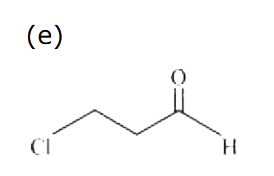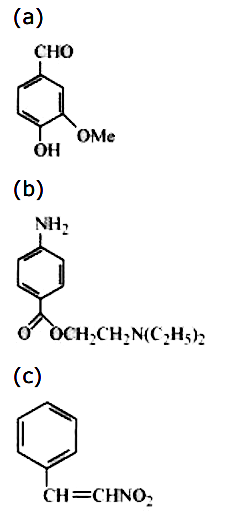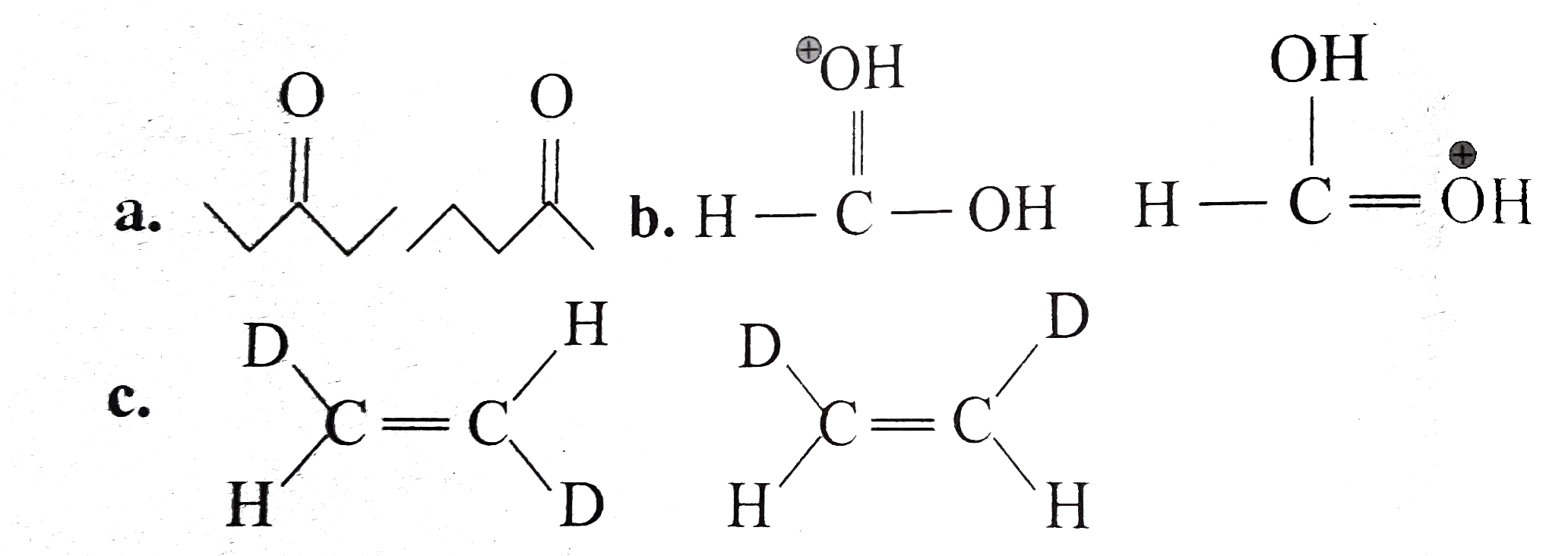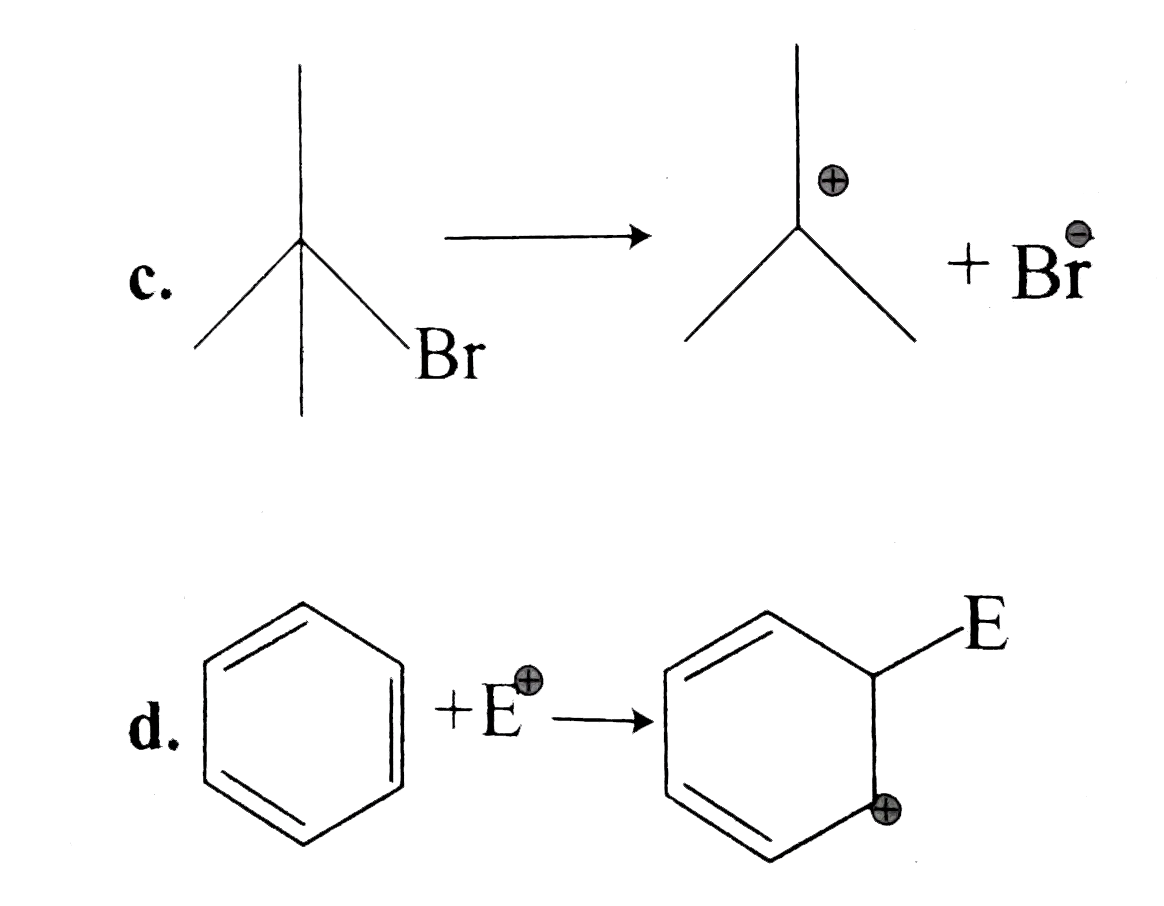Complete Solutions to EXERCISE of chapter ORGANIC CHEMISTRY- SOME BASIC PRINCIPLES AND TECHNIQUES of Class 11 book with complete answers and questions
| Class 11 | CHEMISTRY |
| Chapter | ORGANIC CHEMISTRY- SOME BASIC PRINCIPLES AND TECHNIQUES |
| NCERT | EXERCISE |
| Number Of Questions | 40 |
| Academic Year | 2023-24 |
Given the hybridistaiton state of each carbon in the following compounds :
I. `CH_(2) = C = O` II. `CH_(3) - CH = CH_(2)`
III. `(CH_(3))_(2) CO` IV. `CH_(2) = CH = C -= N`
v. `C_(6) H_(6)`03:13View SolutionIndicate the `sigma-` and `pi -` bonds in the following molecules:
I. `C_(6) H_(6)` II. `C_(6) H_(12)` III. `CH_(2) CI_(2)`
IV. `CH_(2) = C = CH_(2)` V. `CH_(3) NO_(2)`
VI. `HCONHCH_(3)`06:23View SolutionWrite the bond line formula for the following compounds:
I. Isopropyl alcohol II. 2,3-Dimethyl butanal
III. Heptan-4-one02:09View SolutionGive the IUPAC names of the following compounds :

 02:45View Solution
02:45View SolutionWhich of the following represents the corrcet `IUPAC` name for the compounds concerned?
a. 2,2-Dimethy1 pentane or 2-Dimethy1 pentane
b. 2,4,7-Trimethy1octane or 2,5,7-Trimethyloctane
c. 2-Chloro-4-methy1pentane or 4-Chloro-2-melthypentane
d. But-3-yn-1-ol or But-4-ol-1-yne04:05View SolutionDraw the formulae for the first five numbers of each homologous series beginnig with the following compounds:
a. `H - COOH`
b. `CH_(3) COCH_(3)`
c. `H - CH = CH_(2)`04:13View SolutionGive condensed and bond line structural formulas and identify the functional group(s) present, if any, for :
(a) 2,2,4-Trimethylpentane
(b) 2-Hydroxy-1,2,3-propanetricarboxylic acid
(c) Hexanedial04:37View SolutionIdentify the functional groups in the following compounds
 02:34View Solution
02:34View SolutionWhich of the two: `O_(2)NCH_(2)CH_(2)O^(–)` or `CH_(3)CH_(2)O^(–)` is expected to be more stable and why ?
01:46View SolutionExplain why alkyl groups act as electron donors when attacted to a `pi-system`.
04:23View SolutionDraw the resonance structures for the following compounds. Show the electron shift using curved-arrow notation.
(a) `C_(6)H_(5)OH` (b) `C_(6)H_(5)NO_(2)` (c) `CH_(3)CH=CHCHO` (d) `C_(6)H_(5)–CHO` (e) `C_(6)H_(5)-overset(+)CH_(2)` (f) `CH_(3)CH=CHoverset(+)CH_(2)`07:06View SolutionWhat are electrophiles and nucleophiles ? Explain with examples.
02:00View SolutionIdentify the reagents shown in bold in the following equations as nucleophiles or electrophiles:
(a) `CH_(3)COOH+HO^(-)toCH_(3)COO^(-)+H_(2)O`
(b) `CH_(3)COCH_(3)+overset(-)CNto(CH_(3))_(2)C(CN)(OH)`
(c ) `C_(6)H_(6)+CH_(3)overset(+)COtoC_(6)H_(5)COCH_(3)`01:31View SolutionClassify the following reactions in one of the reaction type studied in this unit.
(a) `CH_(3)CH_(2)Br+HS^(-)toCH_(3)CH_(2)SH+Br^(-)`
(b) `(CH_(3))_(2)C=CH_(2)+HCl to(CH_(3))_(2)ClC-CH_(3)`
(c) `CH_(3)CH_(2)Br+HO^(-)toCH_(2)=CH_(2)+H_(2)O+ Br^(-)`
(d) `(CH_(3))_(3)C-CH_(2)OH+HBrto(CH_(3))_(2)CBrCH_(2)CH_(2)CH_(3)+H_(2)O`01:58View SolutionWhat is the relationship between the members of the following pairs of structures describing them as identical , structural, or geometrical isomers, or resonance contributors ?
 .04:48View Solution
.04:48View SolutionFor the following bond cleavages, use curved-arrow to show the electron flow and classify each as homolysis or heterolysis. Identify intermediate products as free radical, carbocation, and carbanion.
(a) `CH_3O - OCH_3 rarr CH_3 dot O+ dot O CH_3`
 .05:22View Solution
.05:22View SolutionExplain the terms Inductive and Electromeric effects. Which electron displacement effect explains the following correct orders of acidity of the carboxylic acids?
(a) `Cl_(3)"CC"OOH gt Cl_(2)CHCOOH gt ClCH_(2)COOH`
(b) `CH_(3)CH_(2)COOHgt(CH_(3))_(2)CHCOOHgt(CH_(3))_(3)C.COOH`04:20View SolutionGive a brief description of the principles of the following techniques taking an example in each case.
(a) Crystallisation (b) Distillation (c) Chromatography02:31View SolutionDescribe the method, which can be used to separate two compounds with different solubilities in a solvent S.
02:31View SolutionWhat is the difference between distillation, distillation under reduced pressure and steam distillation ?
03:08View SolutionDiscuss the chemistry of Lassaigne’s test.
03:06View SolutionDifferentiate between the principle of estimation of nitrogen in an organic compound by (i) Dumas method and (ii) Kjeldahl’s method.
05:13View SolutionDiscuss the principle of estimation of halogens, sulphur and phosphorus present in an organic compound.
05:13View SolutionExplain the principle of paper chromatography.
02:50View SolutionWhy is nitric acid added to sodium extract before adding silver nitrate for testing halogens?
02:53View SolutionExplain the reason for the fusion of an organic compound with metallic sodium for testing nitrogen, sulphur and halogens
01:41View SolutionName a suitable technique of the components from a mixture of calcium sulphate and comphor.
01:37View SolutionExplain why an organic liquid vaporises at a temperature below its boiling point in steam distillation?
02:00View SolutionWill `C Cl_4` give white precipitate of `AgCl` on heating with nitrate? Give reason for your answer
01:27View SolutionWhy is solution of potassium hydroxide used to absorb carbon dioxide evolved during the estimation of carbon present in an organic compound?
02:15View SolutionWhy is it necessary to use acetic acid and not suplhuric acid for the acidification of sodium extract for testing suplhur by lead acetate test?
02:59View SolutionAn organic compound contains `69%` carbon and `4.8%` hydrogen, the remainder being oxygen. Calculate the masses of carbon dioxide and water produced when 0.20 gm of this substance is subjected to complete combustion.
03:31View Solution0.50 gm of an organic compound was treated according to Kjeldahl's meghod. The ammonia evolved was absorbed in 50 ml of 0.5 `MH_2SO_4`. The residual acid required 60 ml of `(M)/(2)NaOH` solution. Find the percentage of nitrogen in the compound.
03:38View Solution0.3080 gm of and organic chloro compound gave 0.5740 gm of siver chloride in carius estimation. Calculate the percentage of chloride presents in the compound
02:36View SolutionIn the estimation of sulphur by carius method, 0.468 gm of an organic sulphur compound afforded 0.668 gm of barium sulphate. Find out the percentage of sulphur in the given compound.
02:14View SolutionIn the organic compound `CH_(2) = CH – CH_(2) – CH_(2) – C equivCH`, the pair of hydridised orbitals involved in the formation of: `C_(2) – C_(3)` bond is:
`(a) sp – sp_(2) (b) sp – sp_(3) (c) sp_(2 )– sp_(3) (d) sp_(3) – sp_(3)`02:31View SolutionIn the Lassaigne’s test for nitrogen in an organic compound, the Prussian blue colour is obtained due to the formation of:
(a) `Na_(4)[Fe(CN)_(6)]` (b) `Fe_(4)[Fe(CN)_(6)]_(3)` (c) `Fe_(2)[Fe(CN)_(6)]` (d) `Fe_(3)[Fe(CN)_(6)]_(4)`02:20View SolutionWhich of the following carbocation is most stable ?
(a) `(CH_(3))_(3)C.overset(+)CH_(2)` (b) `(CH_(3))_(3)overset(+)C` (c) `CH_(3)CH_(2)overset(+)CH_(2)` (d) `CH_(3)overset(+)CHCH_(2)CH_(3)`01:43View SolutionFor the purification of organic compounds, the latest technique followed is
02:12View SolutionThe reaction:
`CH_(3)CH_(2)I + KOH(aq)toCH_(3)CH_(2)OH+KI`
is classified as :
(a) electrophilic substitution (b) nucleophilic substitution
(c) elimination (d) addition01:06View Solution
EXERCISE questions and complete solutions for chapter ORGANIC CHEMISTRY- SOME BASIC PRINCIPLES AND TECHNIQUES of NCERT CHEMISTRY(HINGLISH) of Class 11
